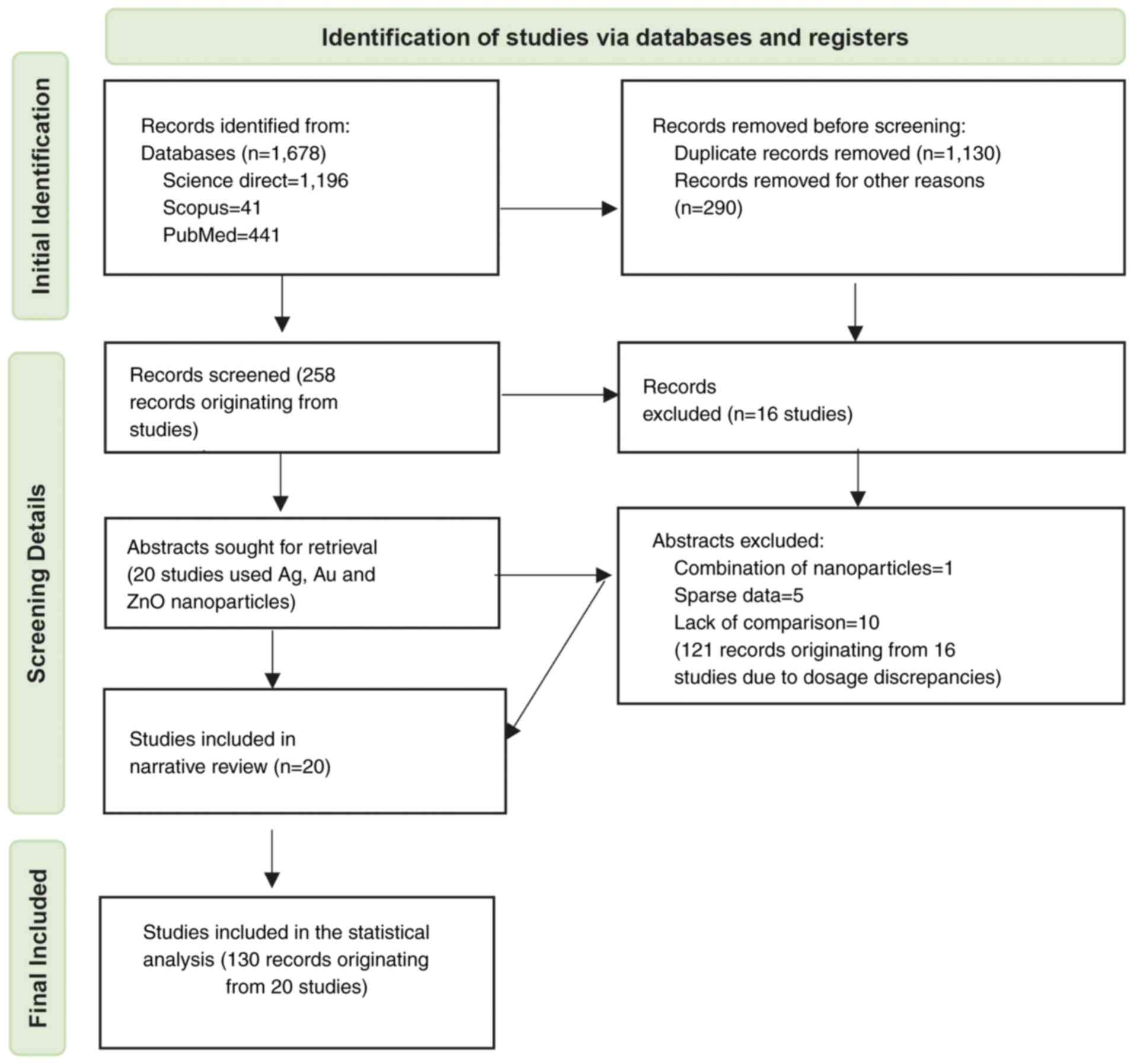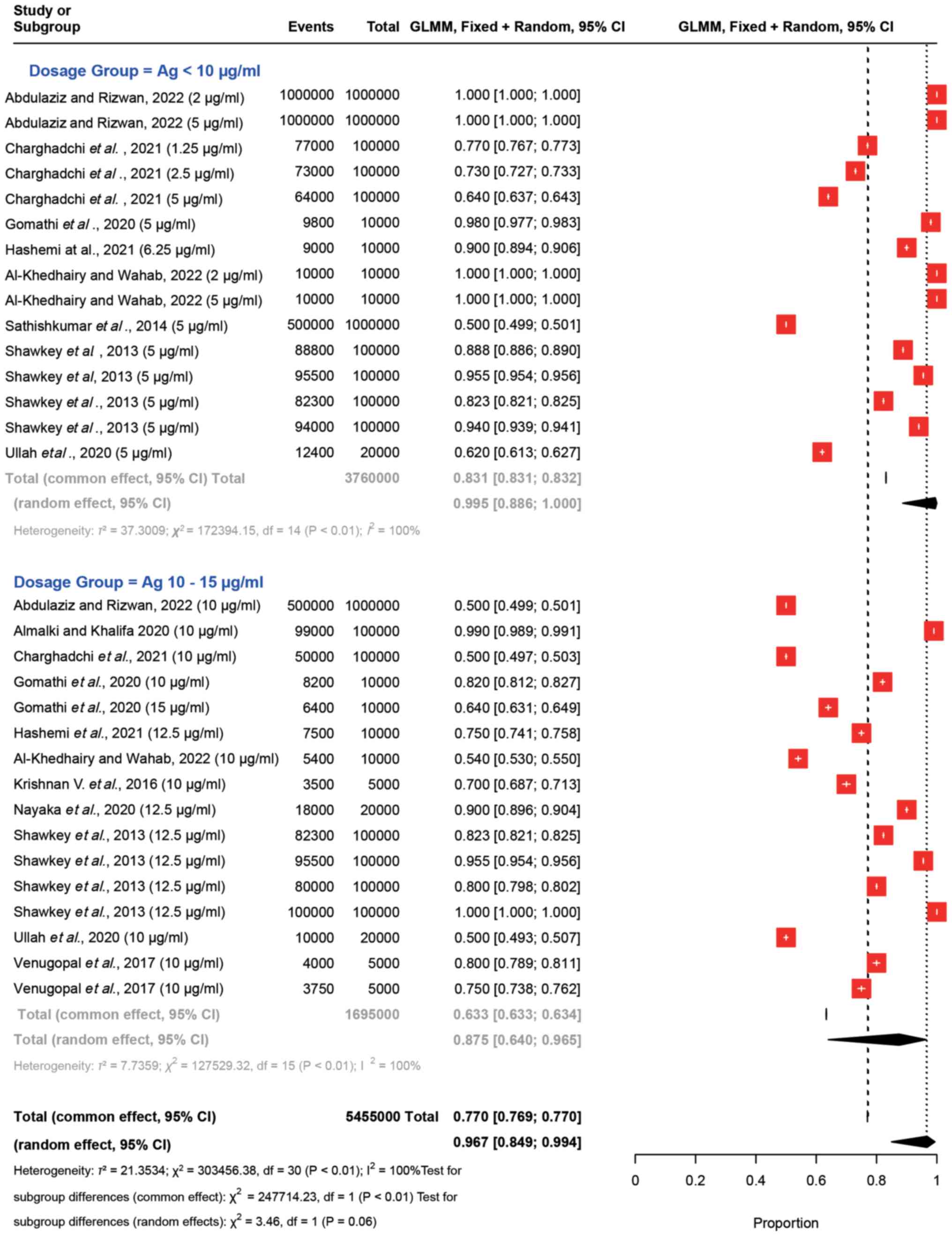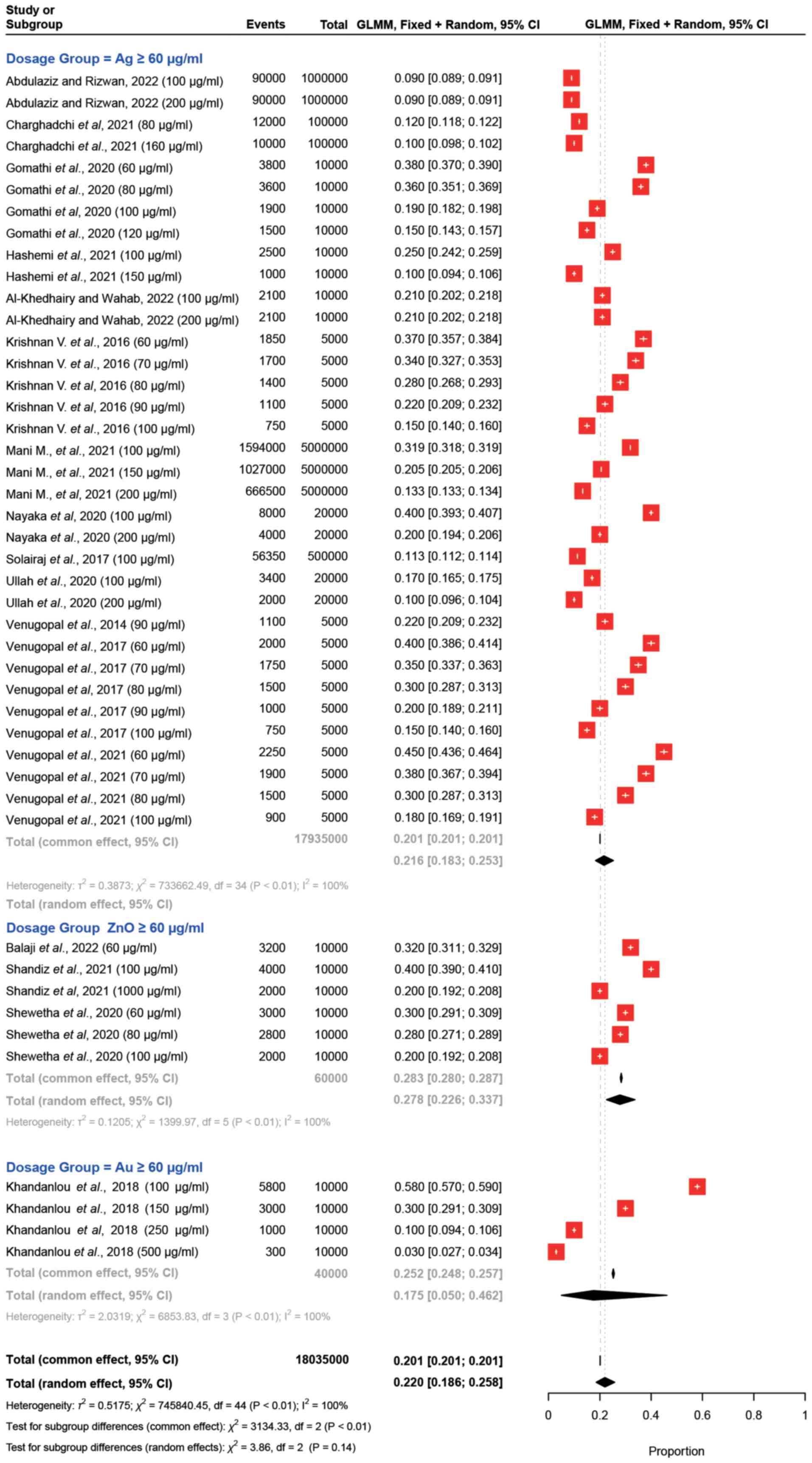|
1
|
World Health Organization (WHO), . Breast
Cancer. WHO; Geneva: 2024, https://www.who.int/news-room/fact-sheets/detail/breast-cancerJuly
3–2024
|
|
2
|
van Meerloo J, Kaspers GJL and Cloos J:
Cell sensitivity assays: The MTT assay. Methods Mol Biol.
731:237–245. 2011. View Article : Google Scholar : PubMed/NCBI
|
|
3
|
Chen X, Fan N, Tan H, Ren B, Yuan G, Jia
Y, Li J, Xiong D, Xing X, Niu X and Hu X: Magnetic and self-healing
chitosan-alginate hydrogel encapsulated gelatin microspheres via
covalent cross-linking for drug delivery. Mater Sci Eng C Mater
Biol Appl. 101:619–629. 2019. View Article : Google Scholar : PubMed/NCBI
|
|
4
|
Dalwadi C and Patel G: Thermosensitive
nanohydrogel of 5-fluorouracil for head and neck cancer:
Preparation, characterization and cytotoxicity assay. Int J
Nanomedicine. 13:31–33. 2018. View Article : Google Scholar : PubMed/NCBI
|
|
5
|
Krutyakov YA, Kudrinskiy AA, Olenin AY and
Lisichkin GV: Synthesis and properties of silver nanoparticles:
Advances and prospects. Russ Chem Rev. 77:2332008. View Article : Google Scholar
|
|
6
|
Chaloupka K, Malam Y and Seifalian AM:
Nanosilver as a new generation of nanoproduct in biomedical
applications. Trends Biotechnol. 28:580–588. 2010. View Article : Google Scholar : PubMed/NCBI
|
|
7
|
Lee DG, Go EB, Lee M, Pak PJ, Kim J and
Chung N: Gold nanoparticles conjugated with resveratrol induce cell
cycle arrest in MCF7 cell lines. Appl Biol Chem. 62:332019.
View Article : Google Scholar
|
|
8
|
Abraham SA, McKenzie C, Masin D, Ng R,
Harasym TO, Mayer LD and Bally MB: In vitro and in vivo
characterization of doxorubicin and vincristine coencapsulated
within liposomes through use of transition metal ion complexation
and pH gradient loading. Clin Cancer Res. 10:728–738. 2004.
View Article : Google Scholar : PubMed/NCBI
|
|
9
|
Byrd JC, Lucas DM, Mone AP, Kitner JB,
Drabick JJ and Grever MR: KRN5500: A novel therapeutic agent with
in vitro activity against human B-cell chronic lymphocytic leukemia
cells mediates cytotoxicity via the intrinsic pathway of apoptosis.
Blood. 101:4547–4550. 2003. View Article : Google Scholar : PubMed/NCBI
|
|
10
|
Page MJ, McKenzie JE, Bossuyt PM, Boutron
I, Hoffmann TC, Mulrow CD, Shamseer L, Tetzlaff JM, Akl EA, Brennan
SE, et al: The PRISMA 2020 statement: An updated guideline for
reporting systematic reviews. BJM. 372:n712021. View Article : Google Scholar : PubMed/NCBI
|
|
11
|
Al-Khedhairy AA and Wahab R: Silver
nanoparticles: An instantaneous solution for anticancer activity
against human liver (HepG2) and breast (MCF7) cancer cells. Metals.
12:1482022. View Article : Google Scholar
|
|
12
|
Almalki MA and Khalifa AYZ: Silver
nanoparticles synthesis from Bacillus sp KFU36 and its anticancer
effect in breast cancer MCF-7 cells via induction of apoptotic
mechanism. J Photochem Photobiol B. 204:1117862020. View Article : Google Scholar : PubMed/NCBI
|
|
13
|
Welch VA, Petkovic J, Jull J, Hartling L,
Klassen T, Kristjansson E, Pardo Pardo J, Petticrew M, Stott DJ,
Thomson D, et al: Chapter 16: Equity and specific populations.
Cochrane Handbook for Systematic Reviews of Interventions (2nd
ediction). Cochrane. 435–448. 2019.
|
|
14
|
West SL, Gartlehner G, Mansfield AJ, Poole
C, Tant C, Lenfestey N, Lux LJ, Amoozegar J, Morton SC, Carey TC,
et al: Comparative effectiveness review methods: Clinical
heterogeneity [Internet]. Agency for Healthcare Research and
Quality (US), Rockville, MD, 2010. https://www.ncbi.nlm.nih.gov/books/NBK53317/table/ch3.t2/
|
|
15
|
Balaji MP, Govindasamy R, Alharbi NS,
Kadaikunnan S, Thiruvengadam M, Baskar V and Rajeswari VD:
Biosynthesis of ZnONP using chamaecostus cuspidatus and their
evolution of anticancer property in MCF-7 and A549 cell lines.
Nanomaterials (Basel). 12:33842022. View Article : Google Scholar : PubMed/NCBI
|
|
16
|
Charghadchi M, Gharari Z, Sadighian S,
Yazdinezhad A and Sharafi A: Green synthesized silver nanostructure
using rhus coriaria fruit extract ınhibits the growth of malignant
MCF7 Cell Line. Braz Arch Biol Technol. 64:e212100692021.
View Article : Google Scholar
|
|
17
|
Gomathi AC, Rajarathinamb SRX, Sadiqc AM
and Rajeshkumard S: Anticancer activity of silver nanoparticles
synthesized using aqueous fruit shell extract of Tamarindus indica
on MCF7 human breast cancer cell line. J Drug Deliv Sci Technol.
55:1013762020. View Article : Google Scholar
|
|
18
|
Hashemi Z, Mohammadyan M, Naderi S, Fakhar
M, Biparva P, Akhtari J and Ebrahimzadeh MA: Green synthesis of
silver nanoparticles using Ferula persica extract (Fp-NPs):
Characterization, antibacterial, antileishmanial, and in vitro
anticancer activities. Mater Today Commun. 27:1022642021.
View Article : Google Scholar
|
|
19
|
Khandanlou R, Murthy V, Saranath D and
Damani H: Synthesis and characterization of gold-conjugated
Backhousia citriodora nanoparticles and their anticancer activity
against MCF7 breast and HepG2 liver cancer cell lines. J Mater Sci.
453:3106–3118. 2018. View Article : Google Scholar
|
|
20
|
Krishnan V, Bupesh G, Manikandan E,
Thanigai Arul K, Magesh S, Kalyanaraman R and Maaza M: Green
synthesis of silver nanoparticles using piper nigrum concoction and
its anticancer activity against MCF7 and Hep-2 cell lines. J
Antimicro. 2:32016.
|
|
21
|
Mani M, Okla MK, Selvaraj S, Ram Kumar A,
Kumaresan S, Muthukumaran A, Kaviyarasu K, El-Tayeb MA, Elbadawi
YB, Almaary KS, et al: A novel biogenic Allium cepa leaf
mediated silver nanoparticles for antimicrobial, antioxidant, and
anticancer effects on MCF-7 cell line. Environ Res. 198:1111992021.
View Article : Google Scholar : PubMed/NCBI
|
|
22
|
Nayaka S, Bhat SMP, Chakraborty B, Pallavi
SS, Airodagi D, Muthuraj R, Halaswamy HM, Dhanyakumara SB,
Shashiraj KN and Kupaneshi C: Seed extract-mediated synthesis of
silver nanoparticles from Putranjiva roxburghii Wall.,
phytochemical characterization, antibacterial activity and
anticancer activity against MCF7 cell line. Indian J Pharm Sei.
82:260–269. 2020.
|
|
23
|
Sathishkumar G, Gobinath C, Wilson A and
Sivaramakrishnan S: Dendrophthoe falcata (L.f) Ettingsh (Neem
mistletoe): A potent bioresource to fabricate silver nanoparticles
for anticancer effect against human breast cancer cells (MCF7).
Spectrochim Acta A Mol Biomol Spectrosc. 128:285–290. 2014.
View Article : Google Scholar : PubMed/NCBI
|
|
24
|
Shandiz SAS, Sharifian F, Behboodi S,
Ghodratpour F and Baghbani-Arani F: Evaluation of metastasis
suppressor genes expression and in vitro anti-cancer effects of
zinc oxide nanoparticles in human breast cancer cell lines MCF7 and
T47D. Avicenna J Med Biotechnol. 13:9–14. 2021.PubMed/NCBI
|
|
25
|
Shawkey AM, Rabeh MA, Abdulall AK and
Abdellatif AO: Green nanotechnology: anticancer activity of silver
nanoparticles using citrullus colocynthis aqueous extracts. Adv
Life Sci Technol. 13:60–70. 2013.
|
|
26
|
Venugopal K, Shanthi MP, Rajagopal K,
Bhaskar M, Uvarajan S and Manikandan E: Bioactivity of cancer cells
(MCF-7 and Hep-2) using plant extract enhanced surface plasmon
resonance (SPR) nanoparticles (Ag NPs). https://www.researchgate.net/publication/312164782
|
|
27
|
Shewetha UR, Latha MS, Rajith Kumar CR,
Kiran MS and Betageri VS: Facile synthesis of zinc oxide
nanoparticles using novel areca catechu leaves extract and their ın
vitro antidiabetic and anticancer studies. J Inorg Organomet Polym
Mater. 30:4876–4883. 2020. View Article : Google Scholar
|
|
28
|
Solairaj D, Rameshthangam P and
Arunachalam G: Anticancer activity of silver and copper embedded
chitin nanocomposites against human breast cancer (MCF-7) cells.
Int J Biol Macromol. 105:608–619. 2017. View Article : Google Scholar : PubMed/NCBI
|
|
29
|
Ullah I, Khalil AT, Ali M, Iqbal J, Ali W,
Alarifi S and Shinwari ZH: Green-synthesized silver nanoparticles
induced apoptotic cell death in MCF-7 breast cancer cells by
generating reactive oxygen species and activating caspase 3 and 9
enzyme activities. Oxid Med Cell Longev. 2020:12153952020.
View Article : Google Scholar : PubMed/NCBI
|
|
30
|
Venugopal K, Ahmadb H, Manikandanc E,
Thanigai Arul K, Kavithae K, Moodleyf MK, Rajagopal K, Balabhaskar
R and Bhaskar M: The impact of anticancer activity upon Beta
vulgaris extract mediated biosynthesized silver nanoparticles
(ag-NPs) against human breast (MCF-7), lung (A549) and pharynx
(Hep-2) cancer cell lines. J Photochem Photobiol B. 173:99–107.
2017. View Article : Google Scholar : PubMed/NCBI
|
|
31
|
Venugopal K, Rather HA, Rajagopal K,
Shanthi MP, Sheriff K, Illiyas M, Rather RA, Manikandan E, Uvarajan
S, Bhaskar M and Maaza M: Synthesis of silver nanoparticles (Ag
NPs) for anticancer activities (MCF 7 breast and A549 lung cell
lines) of the crude extract of Syzygium aromaticum. J
Photochem Photobiol B. 167:282–289. 2017. View Article : Google Scholar : PubMed/NCBI
|
|
32
|
Carlson C, Hussain SM, Schrand AM,
Braydich-Stolle LK, Hess KL, Jones RL and Schlager JJ: Unique
cellular interaction of silver nanoparticles: Size-dependent
generation of reactive oxygen species. J Phys Chem B.
112:13608–13619. 2008. View Article : Google Scholar : PubMed/NCBI
|
|
33
|
Liu X and Feng R: Inhibition of epithelial
to mesenchymal transition in metastatic breast carcinoma cells by
c-Src suppression. Acta Biochim Biophys Sin (Shanghai). 42:496–501.
2010. View Article : Google Scholar : PubMed/NCBI
|
|
34
|
Çiftçi H, Türk M, Tamer U, Karahan S and
Menemen Y: Silver nanoparticles: cytotoxic, apoptotic, and necrotic
effects on MCF7 cells. Turk J Biol. 37:92013. View Article : Google Scholar
|
|
35
|
Chehelgerdi M, Chehelgerdi M, Allela OQB,
Pecho RDC, Jayasankar N, Rao DP, Thamaraikani T, Vasanthan M,
Viktor P, Lakshmaiya N, et al: Progressing nanotechnology to
improve targeted cancer treatment: overcoming hurdles in its
clinical implementation. Mol Cancer. 22:1692023. View Article : Google Scholar : PubMed/NCBI
|
|
36
|
Karlsson HL, Cronholm P, Gustafsson J and
Möller L: Copper oxide nanoparticles are highly toxic: A comparison
between metal oxide nanoparticles and carbon nanotubes. Chem Res
Toxicol. 21:1726–1732. 2008. View Article : Google Scholar : PubMed/NCBI
|
|
37
|
Dusinska M, Boland S, Saunders M,
Juillerat-Jeanneret L, Tran L, Pojana G, Marcomini A, Volkovova K,
Tulinska J, Knudsen LE, et al: Towards an alternative testing
strategy for nanomaterials used in nanomedicine: Lessons from
NanoTEST. Nanotoxicology. 9 (Suppl 1):S118–S132. 2015. View Article : Google Scholar
|














